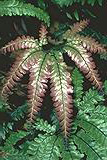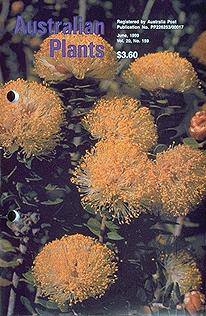|
[Front Page] [Features] [Departments] [SGAP Home Page] [Subscribe]

First Cuttings
Eucalypt Power
The August-October 1999 issue of "Bush Telegraph", published by NSW State Forests, reports a trial to use eucalypts in conjunction with bagasse (waste plant fibre left after the juices have been removed from sugar cane) to produce energy.
 
The trial is being carried out in northern New South Wales as a joint project between NSW State Forests and the NSW Sugar Milling Co-operative Limited. The three trial species are flooded gum (Eucalyptus grandis), spotted gum (Corymbia maculata) and blackbutt (Eucalyptus pilularis). If successful, the trial will lead to a more efficient use of sugar harvesting equipment, provide an alternative use for land near sugar mills and provide a source of 'Green Power'
Select the thumbnail image or highlighted name for a higher resolution image (45k).

Mundulla Yellows
Until a few months ago I had never heard of "Mundulla Yellows" but then I received the following message from Tracy Young:
"I read an article in the local paper about the virus Mundulla Yellow killing off our native trees Australia wide. I have a couple of acres planted with natives and have noticed a 5 year old River Red Gum with the tell tale yellow leaves at the top of the tree. The rest of the leaves have a rusty "rash" over them. Is it too late to save the tree or should I remove and burn it. Does it spread to other natives close by?"
At about the same time, "Mundulla Yellows" featured on Burke's Back Yard on TV so I thought it would be worth finding out a bit more. As it happens, "Mundulla Yellows" was discussed in the Newsletter of the South Australian Region of the Australian Plants Society in the August 1999 issue. That information is repeated here for the benefit of those who have not come across this (apparently) very debilitating plant disease.......
"Mundulla Yellows" (MY) is the name that has been given to a disease that is having a serious impact on native trees and shrubs. The disease progresses slowly, but is always fatal.
MY was first brought to scientific attention by Geoff Cotton, an apiarist from the south east of South Australia who had been watching tree decline in that region for some twenty years. Plants that have symptoms that are consistent with MY have also been found in the Hunter valley in NSW, in western Victoria, in Hobart and Adelaide, and north of Perth. Numerous species of Eucalyptus, Banksia, Acacia and Melaleuca appear to be susceptible to the disease. Dr Frank Podger, a plant pathologist with a wealth of experience in plant diseases (especially Phytophthora impact and control), believes that MY is of equal - if not greater - concern, than is Phytophthora.
The main symptom of MY is a distinctive yellowing of leaf tissue (not unlike lime-induced chlorosis) which begins on a few leaves of a branch. Only a few leaves are affected to begin with. Only after some time do most leaves turn yellow. Sometimes, leaf and fruit deformity is associated with the leaf yellowing. These symptoms then spread slowly until the whole plant is involved. The plant then dies.
The symptoms are especially evident along roadside verges. Because these areas are wetter than nearby farmland, it was initially thought that the symptoms were caused by Phytophthora (a soil/water borne fungus that is often carried around by vehicles). The disease, however, is not entirely consistent with Phytophthora infection.
One of the most important steps in any initial investigation will be to design a system for determining conclusively whether the symptoms that are expressed on a particular plant are those of MY One of the problems with diagnosis is that the symptoms can be confused with, for example, those of lime-induced chlorosis (leaf-yellowing due to the roots of lime-intolerant plants striking limestone). Some descriptive microscopic work has been done, but more is required if a satisfactory system is to be developed. Also being developed is a clear description of the symptoms of MY
In preliminary research into the cause of the disease, Professor John Randles (virologist at the Waite Research Institute) is looking at ways to determine whether we are in fact dealing with a virus. This is being done at the genetic/molecular level and through grafting experiments. A good indication that we are dealing with a biotic disease will be established if the symptoms can be transmitted from an infected branch to an uninfected host via grafting. State Flora has generously donated over 200 River Red Gum (Eucalyptus camaldulensis) seedlings for these grafting experiments.
Research in South Australia is concentrating on the identification and isolation of the cause of MY Current research implicates a microscopic, single-celled organism (called a phytoplasma) which invades plant tissue. It is most probable that the phytoplasma is dispersed by leaf-feeding insects. A similar problem is being investigated in New Zealand, where scientists are finding a phytoplasma that is associated with native plant decline in, for example, Cordyline australis (cabbage tree), Coprosma spp. and Pittosporum tenuifolium.
At this stage, research funding has been sourced only from South Australia, from South Australian Government agencies. Five thousand dollars has been given by the State Revegetation Committee, $23,000 by the Native Vegetation Council, and $10,000 by the Department tor Environment Heritage and Aboriginal Affairs.
However, to adequately deal with the problem funds in the order of $160,000 per annum for an estimated three years will be required. It is important to stress that the problem of MY transcends the issue of conservation and the State of South Australia. It is also of concern to farming (eg. shelter belts), tourism (loss of tree amenity and aesthetics), forestry (Tasmanian bluegum plantations), and the apiary and cut flower industries. What is more, as was stated earlier in this article, MY is not confined to South Australia.
If we are to succeed in gaining an understanding of the problem and what can be done about it, researchers will require the support of more than the conservation agencies and the State of South Australia. MY is a national problem which has the potential to inflict damage on man) national industries. Therefore, nationwide support for research into the disease is essential.
If you would like to know more about Mundulla Yellows contact the Department of Environment, Heritage and Aboriginal Affairs at 284 Portrush Road, Kensington, 5068. Telephone 8204 8888. Fax: 8204 8889, or the Conservation Council of S.A., 120 Wakefield St, Adelaide 5000. Telephone 8223 5155.
You can find a bit more information on MY at Burke's Back Yard but, if anyone has had any first hand experience, please let us know.

Eucalyptus unpredictablis
I don't know if it's due to the unseasonably wet spring this year but the flowering of the Eucalyptus amplifolia (cabbage gums) on my property has been prolific this year. Never in the 18 years that I have lived here have I seen such a profusion of fallen stamens and opercula.
The reason that I mention this is that I noted a report in the Sydney Morning Herald (September 24, 1999) by Science Writer, James Woodford. The report described research by Dr Brad Law of NSW Forests which concluded that, while gum tree flowering patterns exist, "some species are about as messy and unpredictable as a pattern can be".
Sounds like my cabbage gums.......
 |
Cabbage gum, Eucalyptus amplifolia is an imposing tree for parks and larger gardens.
Select the thumbnail image or highlighted name for a higher resolution image (60k).
|
Other findings of the research were that:
- Some hold seeds for a decade after they are fertilised
- Some hold buds in hibernation for up to four years before they are allowed to burst into bloom.
- Some individuals erupt into bursts of colour while their neighbours of the same species remain inexplicably unadorned.
- Millions of years of evolution have also allowed some species to have a partial say in their pollination vectors. Eucalypts with red flowers are most attractive to birds, and those with cream coloured blossoms stand out at night and are prized by nocturnal marsupials and bats.
The research also discovered that, because of the unreliability of flowering, September is one of the toughest times for nectar feeding animals living on the New South Wales coast. Consequently, the animals that depend on eucalypt nectar have to be very mobile.

Australian Ferns: Growing Them Successfully
Just a quick note to let you know of this new publication authored by Calder Chaffey with support from ASGAP's Fern Study Group.
It is hoped that a full review will appear in the next issue of "Australian Plants online" but, to whet your appetite, here are some brief details......
The book is in three parts and includes:
- Part 1: About Ferns - General information about ferns.
- Part 2: About Growing Ferns - Information about ferns and how to grow them.
- Part 3: Ferns to Grow.
- Map of growing zones in Australia.
- Specific information about growing 195 Australian ferns and where they can be grown.
- Brief description of fern families
- 239 colour plates
- Lists of suggested ferns for special locations.
- Glossary
- Abbreviations
- Authors of plant names including translations of the meaning of the names of each fern included, compiled by research of original material, to ascertain why the name was chosen by the fern author and to what part of the fern it refers.
- Synonyms
- References and suggested reading
 |
Rough maidenhair fern, Adiantum hispidulum, is widespread in Australia and also occurs naturally overseas.
Select the thumbnail image or highlighted name for a higher resolution image (42k). Photo: Fred Johnson
|
The book also includes a book mark illustrating fern parts with labels and three spare bookmarks in the back which may be cut out for use.
The price is $65 and the book is available from Florilegium, PO Box 644, Rozelle, NSW, 2039 (florileg@ozemail.com.au)

Net Watch
Thanks to Jim barrow for bringing this site to my attention.......
The Mycorrhizas Webpage includes everything you ever wanted to know about mycorrhizal associations with plants and quite a bit more.
The site is divided into several Sections and includes lots of photos and diagrams most of which are from the introductory chapter of the book Working with Mycorrhizas in Forestry and Agriculture by Mark Brundrett, Neale Bougher, Bernie Dell, Tim Grove and Nick Malajczuk:
- Section 1: Mycorrhizal associations. Types of associations. Where they occur. Host plants.
- Section 2: An introduction to the root structures which influence mycorrhizal fungi. Root systems. Root growth.
- Section 3: The structure and development of vesicular-arbuscular mycorrhizas
- Section 4: The structure, development and function of ectomycorrhizal associations (ECM). Hosts plants.
- Section 5: How mycorrhizas work. Why some plants need mycorrhizas and others do not.
- Section 6: Mycorrhizal associations of Australian plants.
- Section 7: Ectomycorrhizal fungi and roots of Eucalyptus in Australia and other countries.
- Section 8: Methodology used to take photographs used on the site.
- Section 9: Books and cited references.
Another very interesting web site I chanced across is the Field Guide to the Mangroves of Queensland.
Although the Guide is intended for people who wish to identify the plants they encounter in their coastal environment, even if you don't live in coastal Queensland, you will still find much to learn here. Twenty-two of the most commonly occurring mangrove forest plants - both true mangroves and mangrove plant associates - are illustrated together with information about mangrove ecosystems generally.
The site covers:
- The mangrove environment
- How mangroves tolerate their environment
- Mangrove ecosystems
- Animals of the mangroves
- Coastal protection
- Links between mangroves, seagrass beds and coral reefs
- Species identification
- Seeds and propagules
This is the complete reproduction of the book by Catherine Lovelock which was published by the Australian Institute of Marine Science in 1993. The wonderful illustrations are by Steve Clarke.
Not a new site but one that I have missed previously is the Biodiversity Series published by the (former) Commonwealth Department of Environment, Sport and Territories. The Biodiversity Series is a selection of papers from ten environment and biodiversity conferences but, apparently, the site isn't being maintained and in at least one case the links are obsolete....so, if you're interested in any of this, don't delay!
- Biodiversity and its value.
- Australia's Biodiversity: an overview of selected significant components.
- Country in Flames: proceedings of the 1994 symposium on biodiversity and fire in North Australia.
- Refugia for Biological Diversity in Arid and Semi-arid Australia.
- Two Way Track - Biodiversity Conservation and Ecotourism: an investigation of linkages, mutual benefits and future opportunities.
- Native Vegetation Clearance, Habitat Loss and Biodiversity Decline
- Landcover Disturbance over the Australian Continent: a contemporary assessment.
- Fire and Biodiversity: The Effects and Effectiveness of Fire Management.
- Reimbursing the Future - An evaluation of motivational, voluntary, price-based, property-right, and regulatory incentives for the conservation of biodiversity.
- Approaches to Bioregional Planning: A framework for biodiversity conservation and ecological sustainability
 
The results of a computer simulation study that shows the response of a stand of Callitris intratropica to various fire frequencies and intensities over the past 300 year period. The histograms are symolic portrayals of different size-class distributions that are produced by the various fire regimes.
From the "Country in Flames" series: Why the skillful use of fire is critical for the management of biodiversity in Northern Australia, David Bowman, Conservation Commission of the Northern Territory, Darwin.

Australian Plants....in print!!!
"Australian Plants online" is a fairly recent publication of the Association of Societies for Growing Australian Plants but the Society has been involved in publishing for much longer....since 1959 to be exact, when the first issue of the journal "Australian Plants' was published.


"Australian Plants" is a 48 page, quarterly journal packed with information of practical interest to the average grower but also including reports on recent scientific research. The journal is liberally illustrated with colour photographs and drawings and has built up a high reputation since its first issue in 1959. It is held in many libraries both in Australia and overseas.
The journal regularly features up-to-date information on new species, new cultivars and hybrids, new propagation techniques and plant identification changes.
The "Australian Plants" journal is included with Society membership (either as a standard benefit or by means of an additional fee). It is also possible to subscribe to independently of Society membership. The cost is $18 annually ($AUS32 overseas), including postage. If you would like to subscribe, print out the Subscription Form and post or fax the appropriate fee to the address indicated on the form.
Here's a sample of some of the topics covered in recent issues,
Plants for wet areas
Philotheca and Eriostemon - name changes
Lilly Pilly cultivars
Tropical legumes
Eucalyptus cinerea - lignotuber studies
Nutritional needs of Proteaceae
Labichea and Petalostylis
Xyris in Australia
Ferns in a garden
Yellow Waratah...Telopea truncata form
"Pines" of Tasmania
Tasmanian plants in horticulture in Britain
Eucalypts of Tasmania
Cut flower production trials
Emu Bush - Growing Eremophila
Kangaroo Paws - for colour
Creating a native garden...For beginners
Native honeysuckle; The genus Lambertia
Fertilizing for grevilleas
Creating homes for birds and mammals
Mistletoe; their natural biological control
|
Bladderworts - carnivorous plants
New Banksia releases
Edible wattle seeds - southern Australia
An introduction to legumes of Australia
Bernawarra Gardens, Tasmania
Orchids as garden features
Native lowland grasslands of Tasmania
Orities - Tasmanian endemics
Gardening in clay
The daisy family
The tea tree oil industry
Riceflower - an everlasting daisy as a cut flower
Corkwood as a source of medicine
Outback Gardening - Achieving water efficiency
Pioneering Quandong as a fruit
Commercial cropping in the dry Interior
Bush food plantations
Rainforest plants- horticulture and bush tucker
Native fruits - Aboriginal food
About plant roots
NSW Christmas Bush: Cut flower industry
|
Good growing
Brian Walters

[Front Page] [Features] [Departments] [SGAP Home Page] [Subscribe]
Australian Plants online - December 1999
Association of Societies for Growing Australian Plants
|